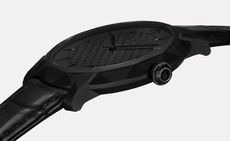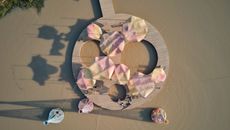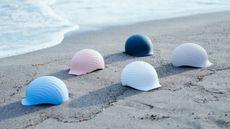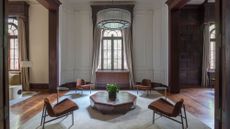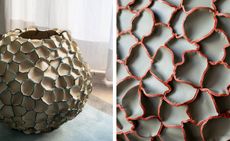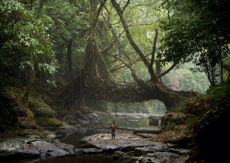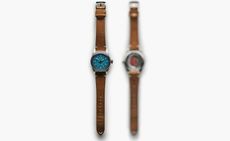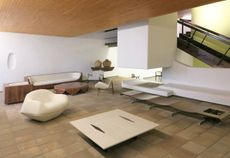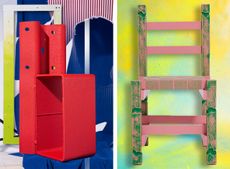Wentz presents innovative furniture incorporating ocean plastic waste
The ‘Mar’ collection by Guilherme Wentz is informed by the sea and features computerised 3D-weaving techniques to transform ocean-borne plastic
- (opens in new tab)
- (opens in new tab)
- (opens in new tab)
- Sign up to our newsletter Newsletter
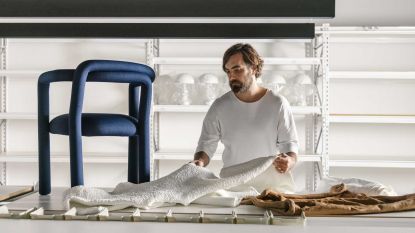
In just a few short years, Guilherme Wentz has established himself as one of the most important new Brazilian furniture designers, not by imitating the long line of modern masters that came before him but with his own minimal, contemporary style. His body of work is evolving quickly, becoming more technical and reflective of the designer’s values.
Wentz, who is based in the southern Brazilian city of Caxias do Sul, launched his first line in 2019. The clean, crisp collection didn’t necessarily look like a tribute to nature, but was informed by his time on the beaches surrounding Punta del Este, Uruguay, one of his favourite destinations. Nature, and the ocean in particular, is a passion for Wentz, informing all of his work. But he is quickly progressing from taking inspiration from nature to taking action on the environmental crisis that threatens it.
Mar by Wentz: ‘designing to make a difference’

‘Onda’ coffee table
With his latest collection, titled 'Mar', or ‘sea’ in Portuguese, Wentz is not just taking inspiration from the water; he is harvesting ocean-borne plastic waste to incorporate into the line. The collection comprises the ‘Onda’ and ‘Mare’ coffee tables, elegant marble-topped pieces with wave-inspired details that are unexpected given the choice of material. There is also a special edition of his popular ‘Vidro’ glass side table, but the highlights of the effort are the ‘Canoa’ lounge chair and ‘Tubo’ dining chair.

'Tubo' dining chair

'Canoa' lounge chair
Both chairs are upholstered with fabric woven from virgin polyester and recycled ocean plastic using a computerised 3D-weaving technique. Developed by the clothing industry, it allows an entire slipcover to be created in one continuous piece, pre-shaped to match the chair’s form. The pieces are then hand-fitted and finished with thread that is also made of recycled plastic. Wentz has trademarked this innovative process under the name We-Knit, which yields seamless, surprising shapes. It’s hard to imagine either of these chairs being possible without this technology, particularly the intertwined cylindrical shapes of the ‘Tubo’.

Guilherme Wentz's studio in Caxias do Sul
These pieces represent a turning point in Wentz’s career, not just for their intriguing design or innovative fabrication method but because they mark a permanent shift for him and his company. ‘I’ve stopped designing for designers. Now, I’m designing to make a difference. I want to use my craft to make things better for the environment in everything I do,’ he says.
Wentz cites sportswear and fashion industry leaders Patagonia and Osklen as examples to follow. ‘These brands have a different way of thinking, of being, and they create products that respect the Earth. I want to be more than an interiors company. I want to be a new kind of lifestyle brand based on values, one that shows leadership with a new way of working that benefits the environment.’
Wentz is well on his way, not just with his new approach to upholstered furniture but also with lighting and, eventually, accessories. He recently launched a new office, design studio, and manufacturing facility dedicated to lighting production. Here, he plans to evolve the lighting division of his business in the same environmentally conscious way. ‘We are working with recycled aluminium, and LED has made a big difference, but we are looking at other materials and the manufacturing process to meet the new standards we have set with fabrics. We have to do it.’
wentz.design (opens in new tab)

‘Canoa’ lounge chair

'Tubo' dining chair and ‘Canoa’ lounge chair
-
 All-black Graff Eclipse watch goes to the dark side
All-black Graff Eclipse watch goes to the dark sideThe lightweight and slender Graff Eclipse watch has been rethought in an updated iteration
By Hannah Silver • Published
-
 Wonderfruit 2022 balances art, culture, music and nature in Thailand
Wonderfruit 2022 balances art, culture, music and nature in ThailandWonderfruit 2022 featured a masterplan by Ab Rogers with pavilions and installations that blend art and culture, music and nature
By Daven Wu • Published
-
 Men’s engagement rings for modern grooms
Men’s engagement rings for modern groomsMen’s engagement rings, whether classic or colourful, make for sentimental tokens
By Hannah Silver • Published
-
 Shellmet: the helmet made from waste scallop shells
Shellmet: the helmet made from waste scallop shellsShellmet is a new helmet design by TBWA\Hakuhodo’s creative team and Osaka-based Koushi Chemical Industry Co, made using Hokkaido’s discarded scallop shells
By Jens H Jensen • Published
-
 Casa Higienópolis: a São Paulo mansion reborn to display the best of Brazilian style and history
Casa Higienópolis: a São Paulo mansion reborn to display the best of Brazilian style and historyCasa Higienópolis is the latest revival project by retail company Iguatemi, a mansion merging neoclassical style and Brazilian flair
By Scott Mitchem • Published
-
 Liaigre ‘Upcrafted’ objects showcase potential of sustainable design
Liaigre ‘Upcrafted’ objects showcase potential of sustainable designStriding confidently towards more sustainable production, interior design company Liaigre has released ‘Upcrafted’, a series of limited-edition objects for the home, assembled attentively from the studio’s would-be waste
By Martha Elliott • Last updated
-
 Regenerative design: meet the creatives taking a rooting interest in learning from nature
Regenerative design: meet the creatives taking a rooting interest in learning from natureRegenerative design: meet the creatives taking a rooting interest in learning from nature
By Malaika Byng • Last updated
-
 No time for waste: Oris’ collaboration with a leather manufacturer recycles deer skins
No time for waste: Oris’ collaboration with a leather manufacturer recycles deer skinsDeer skins make for sustainable watch straps in a partnership between Oris and Cervo Volante
By Hannah Silver • Last updated
-
 Cooking Sections champions regenerative eating at the Serpentine’s The Magazine restaurant
Cooking Sections champions regenerative eating at the Serpentine’s The Magazine restaurantLondon-based artist duo Cooking Sections has created a menu of three dishes for The Magazine restaurant at Serpentine North, as part of the museum’s ‘Back to Earth’ programme featuring artistic responses to the climate emergency
By Sheila Lam • Last updated
-
 Step into Jorge Zalszupin’s design legacy
Step into Jorge Zalszupin’s design legacyLed by Brazilian design brand Etel, Casa Museo Zalszupin preserves the Brazilian designer’s legacy and celebrates his impact on the design world
By Rosa Bertoli • Last updated
-
 Best recycled designs from the Wallpaper* Design Awards
Best recycled designs from the Wallpaper* Design AwardsContemporary designers are using waste to create furniture designs that combine a distinctive aesthetic with a sustainable approach
By Anne Soward • Last updated
